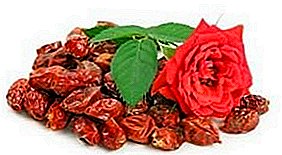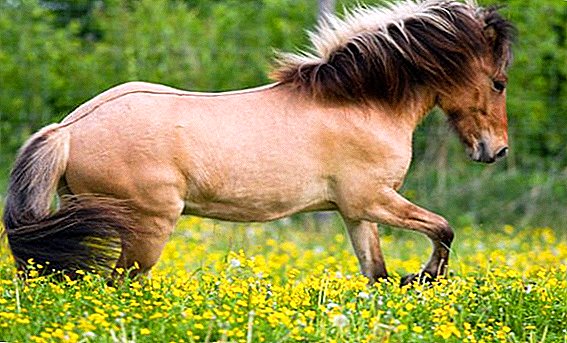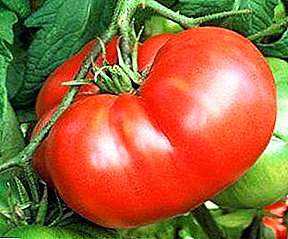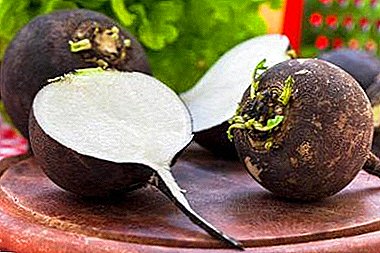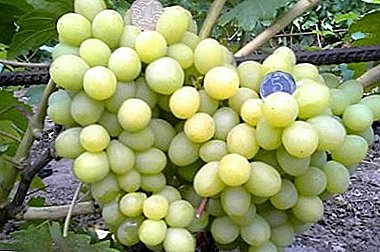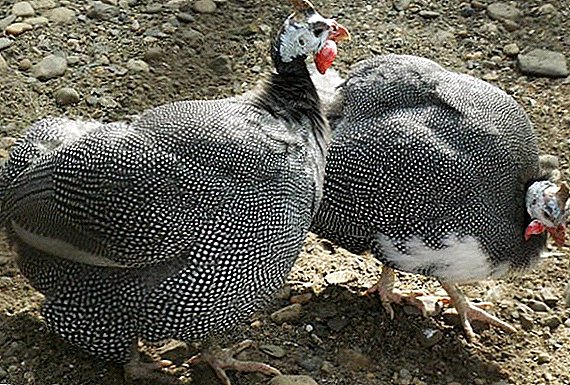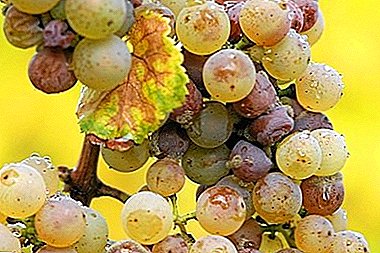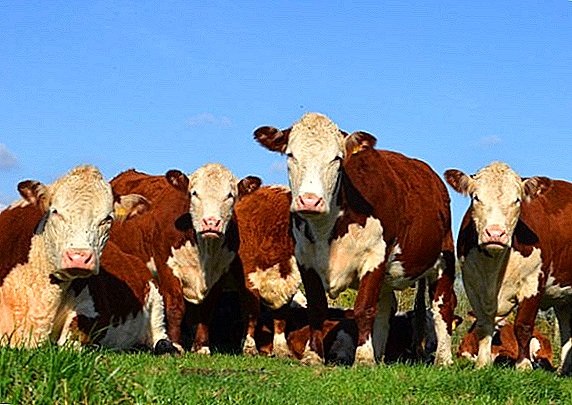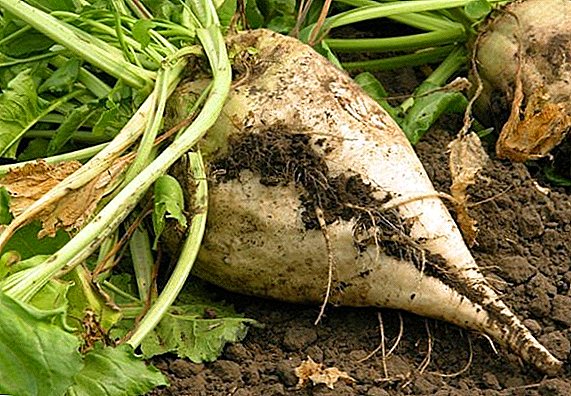 As a rule, people have no doubt that sugar beet is only a raw material for industrial processing, and only large agribusinesses or farms are engaged in its cultivation. Meanwhile, the technology of cultivation of sugar beet is quite available on the garden beds familiar to each owner of a small land plot.
As a rule, people have no doubt that sugar beet is only a raw material for industrial processing, and only large agribusinesses or farms are engaged in its cultivation. Meanwhile, the technology of cultivation of sugar beet is quite available on the garden beds familiar to each owner of a small land plot.
Sugar beet: description
Sugar beet is a subspecies of the usual root beet. The result of the first year of life of this two-year-old plant is a white root vegetable extended in length and formed by a rosette foliage. In small farms, such beets are grown not for sugar production, but for use in home cooking, as feed for livestock and poultry, as well as for the application of a therapeutic agent recommended by traditional medicine.  The presence of beet root vegetables, in addition to sucrose, also a huge amount of nutrients (vitamins B, C and PP, magnesium, iodine, iron and other mineral and other elements) caused their beneficial effects on the human body, including for various diseases.
The presence of beet root vegetables, in addition to sucrose, also a huge amount of nutrients (vitamins B, C and PP, magnesium, iodine, iron and other mineral and other elements) caused their beneficial effects on the human body, including for various diseases.
Important! The use of sugar beet is contraindicated for patients with diabetes.
Selection of soil for growing sugar beets
Sugar beets most successfully grows on light acid-neutral soil typeshaving good air and moisture permeability. The best option is chernozem. Plowed drained peatlands and sierozems will also be quite comfortable for sugar beets.
 One of the most important conditions for convenient cultivation and future high yields of sugar beet is available at depth 0.6-0.8 m subsoil horizon with water retaining properties - a layer closer to the growing root crop will create conditions for the formation of rot, and lowering it below the specified level will slow down the growth of the underground part of the beet.
One of the most important conditions for convenient cultivation and future high yields of sugar beet is available at depth 0.6-0.8 m subsoil horizon with water retaining properties - a layer closer to the growing root crop will create conditions for the formation of rot, and lowering it below the specified level will slow down the growth of the underground part of the beet.
Did you know? The weight of the heaviest beet grown in Somerset in 2001 was 23.4 kg.
Beet predecessors in the rotation
You can not plant sugar beets on the site after the same and other types of beets, as well as after chard, spinach, rapeseed, rape, camelina, mustard, forage rutabagas, cabbage and kohlrabi, finally, after turnip, radish and radish, cabbage and legumes. This is due to the high risk of similar pests.
But the best predecessors for sugar beet are winter wheat and barley. If the potatoes grown on the site have been successfully cleared of weeds (they have common beets with them), then this land is quite suitable for planting sugar beets. For owners of dachas and small plots, this option is most preferable, since winter grains are practically not grown on several acres.
Autumn and spring tillage
 Agricultural sugar beet involves the beginning of the preparation of the beds in the fall. That's when the first digging is done. In the spring, the area is leveled as a precautionary measure in order to avoid moisture stagnation and for its even distribution in the ground.
Agricultural sugar beet involves the beginning of the preparation of the beds in the fall. That's when the first digging is done. In the spring, the area is leveled as a precautionary measure in order to avoid moisture stagnation and for its even distribution in the ground.
Fertilizer for beets
Under the autumn digging the soil for sugar beet must be enriched, along with a solid (35 kg per hundred) lining of manure, potash-phosphate fertilizers (2 kg / sotka). At the same time or about two weeks before sowing, it is recommended to introduce nitrogenous substances (0.9-1.0 kg / sotka). With the use of nitrogen fertilizer for beets need to be careful, because nitrogen has the property of rapid accumulation in the roots. However, after planting, it is allowed to use a solution of nitrogen fertilizer at a rate of 1.25 g per liter of water for irrigation.
 Directly during sowing, granulated superphosphate (200 g / sotka) is added to the soil, 4 cm deeper than seeds. When root crops gain mass, such supplements already made will successfully support this process. For foliar and foliar application, a carbamide-ammonia mixture (1.5 l / sotka) is used every month, completing the feeding three weeks before the planned harvest date.
Directly during sowing, granulated superphosphate (200 g / sotka) is added to the soil, 4 cm deeper than seeds. When root crops gain mass, such supplements already made will successfully support this process. For foliar and foliar application, a carbamide-ammonia mixture (1.5 l / sotka) is used every month, completing the feeding three weeks before the planned harvest date.
Selection of beet varieties
Varieties and hybrids of sugar beet can be classified according to their sugar content. According to this indicator, they are rather arbitrary (there is no overly rigid dependence between yield and sugar content) divided into three groups.
| Name of varieties | Sugar content,% | Degree of yield |
| Yield | up to 16.5 | High |
| Sugar-yielding | up to 18.5 | Average |
| Sugar | up to 20.5 | Low |
Important! When buying seeds, take care that their size is not less than 3.5 cm, otherwise you risk to be left without a crop.
 The most famous among gardeners involved in this crop are the following varieties and hybridshaving good quality indicators, first of all, by how much beets can be obtained from 1 hectare:
The most famous among gardeners involved in this crop are the following varieties and hybridshaving good quality indicators, first of all, by how much beets can be obtained from 1 hectare:- Sugar beet varietiesBohemia"gives root crops with excellent (up to 19%) sugar content and an average weight of 2 kg at a yield of 300 kg / ha (3 centners from each weave). Bohemia's ripening period is 80 days. Immunity to rot gives the prospect of long-term storage.
- Root beet varieties "Bona"weigh no more than 0.3 kg, which somewhat simplifies cleaning to that of a small (100 kg / ha) crop. The sugar content slightly exceeds 12%, but this variety is fast (84 days) ripen and has an increased resistance to drought, which is rare for beet varieties.
- The German hybrid shows excellent yieldAraxia"- 800 kg / ha with an optimal sugar content of 16.4%. Such fecundity is achieved, in particular, due to the fact that in its root crops there is practically no hollow.
- Also demonstrates resistance to hollowness and a native of Germany "Big Ben", which, having a yield of 720 c / ha, is able to surprise with a sugar content of over 17.5%.
Did you know? Traditional healers recommend regular consumption of sugar beet wishing to rejuvenate the body.
Sowing beets
Sowing sugar beet seeds in the spring. An indicator of the critical time is the achievement of a ground temperature of 6-8 degrees Celsius at a depth of 5 cm. If the seeds before sowing for a few hours soak in a solution of wood ash, sugar beets will ascend much faster.
 The depth of planting ranges from 2-4 cm, depending on the severity of the soil, the row spacing is 45 cm. The sowing process itself can be done in the form of filling a previously prepared groove with a thin stream of sand and seed mixture (10 kg of sand per 1000 seeds). After landing over the filled groove, the shape of the ridge is restored.
The depth of planting ranges from 2-4 cm, depending on the severity of the soil, the row spacing is 45 cm. The sowing process itself can be done in the form of filling a previously prepared groove with a thin stream of sand and seed mixture (10 kg of sand per 1000 seeds). After landing over the filled groove, the shape of the ridge is restored.
As the seedlings appear and grow, two successive thinning is done: the first is 5-6 cm, the second is 15-18 cm. The growing beet loves moisture and loose soil. The first abundant watering should be done immediately after sowing. Further watering is particularly well perceived by the plant if done with sprinkling.
Weed protection
Under household conditions, ordinary weeding is most widely used as a method of weed control, which, as in the case of potato cultivation, is tedious and time consuming. However, this will provide an opportunity to avoid the use of herbicides.
If the use of a chemical method of protection is deemed expedient or necessary, then it is recommended to limit post-emergence (only for the growing season) the introduction of herbicidal preparations based on fen and desmedipham. The application procedure is carried out only in the morning or in the evening, when the air temperature near the ground is in the range of 15-25 degrees. The weather forecast must be taken into account so that natural precipitation does not occur earlier than 6 hours after spraying.
Pests and diseases
 Sugar beet is sick most often brown or late rotcaused by fungus. To combat it, as well as with any pests, among which the most known are beet aphid and beet nematode, during the growing season they use alternating use (spraying and irrigation) of Fitosporin fungicide and Fitoterm intecicide - biologically pure preparations that do not contaminate the soil not able to accumulate in plants and not reducing yields. In addition, "Fitosporin" is used for tillage and compost, when they make pre-sowing soil loosening.
Sugar beet is sick most often brown or late rotcaused by fungus. To combat it, as well as with any pests, among which the most known are beet aphid and beet nematode, during the growing season they use alternating use (spraying and irrigation) of Fitosporin fungicide and Fitoterm intecicide - biologically pure preparations that do not contaminate the soil not able to accumulate in plants and not reducing yields. In addition, "Fitosporin" is used for tillage and compost, when they make pre-sowing soil loosening.
Harvest
You can start harvesting at the end of September. When sugar beets are harvested, special attention is paid to the careful handling of elongated and therefore very brittle root vegetables. Their damage dramatically reduces shelf life.
For the storage itself, the optimum temperature is + 1 ... +3 ° C. But you can use the natural conditions, keeping the sugar beets in a frozen state. However, the latter is possible only in a really harsh climate, since the temperature will be optimal at -14 ... -16 ° С, and its increase over -7 ° С may become fatal for quality characteristics.
In the absence of a room that can be used as a vegetable store, sugar beets are stored in traditional piles or trenches, carefully covered with insulating materials (straw, sawdust, or well-tamped snow).  Sugar beet will be good and useful in a variety of salads. In homemade baking, she can easily replace sugar. Seasoned with sweet beet pieces feed mixture like livestock. Poultry is faster in weight, having a dietary supplement in the form of sugar beet, therefore, it is added in a grated form to grain feed. In combination with medicinal properties, all these advantages more than compensate for the efforts expended on the cultivation of sugar beet.
Sugar beet will be good and useful in a variety of salads. In homemade baking, she can easily replace sugar. Seasoned with sweet beet pieces feed mixture like livestock. Poultry is faster in weight, having a dietary supplement in the form of sugar beet, therefore, it is added in a grated form to grain feed. In combination with medicinal properties, all these advantages more than compensate for the efforts expended on the cultivation of sugar beet.


